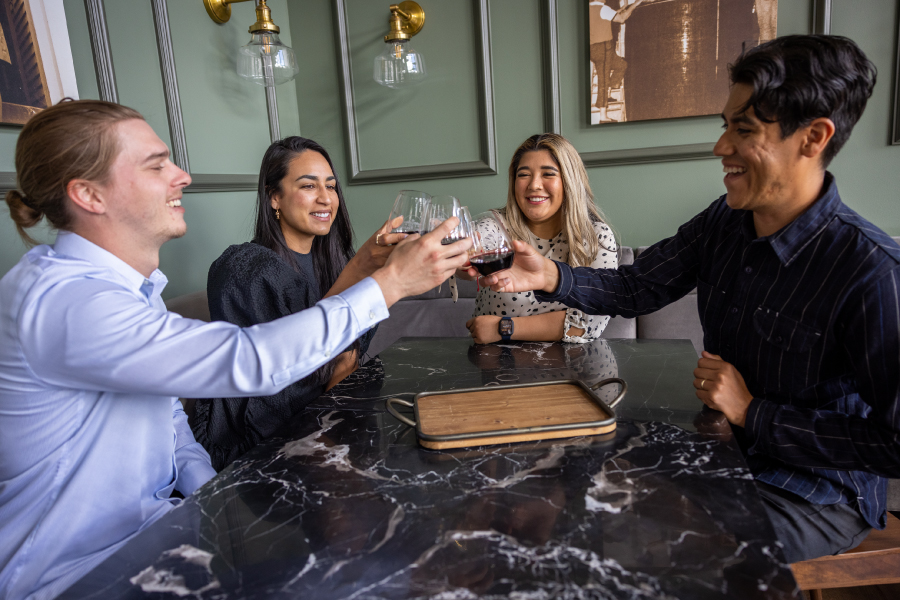What’s the rush? Take time to roam along this short roadside trail
By Melissa Queen
Sometime 15,000 years or so ago, when the Missoula flood waters were raging across Montana, Idaho, and Washington, they had to pause and stop for a while at the Wallula Gap. Held back by the strong basalt rock ridges on either side of a narrow river canyon, the massive volume of flood waters couldn’t fit through the narrow gap, so they backed up and up and up until all of the land we know as the Columbia River Basin today was submerged under a deep yet temporary great lake.

And still to this day the Wallula Gap continues to offer those rushing through reason to pause and stop, lingering long enough to take in the beautiful landscape.
If you’re planning a roadtrip to Walla Walla, especially for those coming from Portland or from the Pasco Airport, it’s worth stopping along the way for a scenic stretch break and a short hike to the Twin Sisters Rock in the Wallula Gap area.
Perched above the ridge overlooking the Columbia River are two towering basalt pillars known as the Twin Sisters Rock.
The formation of the Wallula Gap area and the significant role it has played in shaping the landscape of most of Eastern Washington has a fascinating geologic history. And the formation of the Twin Sisters Rock specifically carries its own legendary significance.


According to the legends of the Cayuse tribe, who inhabited the Columbia Plateau, the two basalt pillars were formed by the misdeeds of the trickster Coyote. Out of jealousy, he turned two sisters into stone, before turning himself into a rock to keep watch on them forever. Of course, a geologist might explain it a bit differently.
But regardless, everything here feels larger than life – the mythology, the geology, and the skyline. And it’s all reachable from a short little trail right off the road.
The trail up to the Twin Sisters Rock is 0.7 miles, out and back from the pullout off the highway. The walk to the top of the bluff is easy, but the closer you get to the Twin Sisters pillars, the rockier the footing becomes. Even if you don’t feel much up for scrambling around the exposed basalt formation, the easy-going trail up to the top of the bluff is still well worth the views.
Traveling to Walla Walla from Portland:
- After passing through Boardman on I-84 East, take exit 179 for I-82 W towards Hermiston. After 9 miles, take exit 1 for US-395 S / US-730. Turn right onto US-730 E. Continue driving along US-730 for 23 miles. The trailhead and parking pullout is on the right side of the road at mile post 4.1.
- After hiking the Twin Sisters Trail, continue driving along US-730 E. At just under two miles, pass the Wallula Junction where US-730 E merges with US-12 E. Continue on US-12 E for about 30 miles, arriving in Walla Walla.
Traveling to Walla Walla from Seattle:
- After passing through Tri Cities on US-12 E, turn right at the Wallula Junction onto US-730 W towards Pendleton. After just two miles, the trailhead and parking pullout will be on the left side of the road at mile post 4.1.
- After hiking the Twin Sisters Rock Trail, drive back on US-730 E towards the Wallula Junction. Instead of turning left at the junction back towards Tri-Cities, continue straight on US-12 E for about 30 miles to Walla Walla.
After hiking the Twin Sisters Rock Trail and continuing on to Walla Walla, there are several notable wineries along US-12 on the outskirts of town, such as Woodward Canyon or L’Ecole No. 41.

Founded in 1981, Woodward Canyon was the second winery ever established in the Walla Walla Valley. Laying down strong roots, its owners were instrumental in establishing the Walla Walla Valley Appellation back in 1984, paving the way for Walla Walla Valley to become Best Wine Region in America for three years running.
The next winery founded in this region was established in 1983: L’Ecole No 41 Winery. With their commitment to sustainability within the industry, a tasting at L’Ecole is quite educational, expanding guests’ understanding and appreciation for both the ecology and the enology of this region. A L’Ecole tasting experience is the perfect finish to a Twin Sisters Rock Trail hike. After taking in the expansive views of the complex geology of this area, stop in to the L’Ecole tasting room to learn about how the thin soil and fractured basalt that characterize the landscape surrounding the Twin Sisters Rocks also characterize the wines of this region.

Things to know before you go:
- The geographic region containing the Twin Sisters Rock Trail, the Wallula Gap, and the confluence of the Snake and Columbia rivers holds a great deal of historic, cultural, economic and environmental significance for the sovereign Native tribes from the Columbia Basin region. Learn more about how the confluence of the Columbia and Snake rivers and the surrounding area help to foster culture and support these tribes’ way of life.
- If you pack it in, pack it out. If you aren’t already, get familiar with these basic seven principles of Leave No Trace for protecting and preserving natural landscapes.
- The Twin Sisters Rock Trail is dog friendly.
- There are no bathroom facilities or potable water sources. Even though this isn’t a long hike, it’s always a good idea to be prepared.
- The Twin Sisters Rock Trail is on public land, but private ranch land surrounds this area. Please be respectful of property boundaries and stay on the trails. Access to the trail is free. There are no recreation fees or passes required, even for vehicle access.


